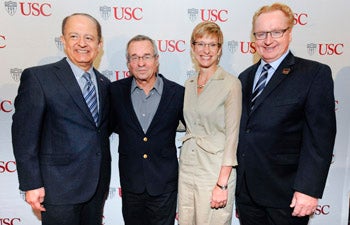Arieh Warshel Wins Nobel Prize
Arieh Warshel, Distinguished Professor of Chemistry at the USC Dornsife College of Letters, Arts and Sciences and fellow of the National Academy of Sciences, has earned a new title: Nobel Laureate.
The Royal Swedish Academy of Sciences awarded the Nobel Prize in Chemistry for 2013 on Oct. 9 to Warshel and two colleagues for developing the key principles behind computer simulations that are now indispensable in the study of chemical reactions.
Warshel, Martin Karplus of the Université de Strasbourg in France and Harvard University, and Michael Levitt of Stanford University were recognized for “the development of multiscale models for complex chemical systems.” Their crucial achievement was to marry classical and quantum mechanics in order to model both the relatively large-scale movements of atoms in a molecule, and the minute dances of the free electrons that shuttle between atoms and spark many chemical reactions.

USC Dornsife Distinguished Professor Arieh Warshel (second from left) celebrates his 2013 Nobel Prize with (from left), USC President C. L. Max Nikias, USC Provost Elizabeth Garrett and USC Dornsife Dean Steve Kay. Photo by Gus Ruelas.
“We are particularly proud that Distinguished Professor Warshel has had such a long and illustrious career at USC,” said USC President C. L. Max Nikias. “Over nearly four decades, his pioneering computer simulations and multiscale models have advanced the field of chemistry and advanced human knowledge and understanding. This tremendous honor speaks volumes about the quality of his research and the quality of USC’s faculty.”
USC Dornsife Dean Steve Kay called Warshel a trailblazer of the highest order.
“Having co-founded the field of computational enzymology, Dr. Warshel’s work modeling the functions of biological molecules has allowed us to understand how life processes operate on the protein level,” Kay said. “For more than 35 years, it has been our privilege at USC Dornsife to work alongside him and to bear witness to his pioneering efforts. In addition, he is a beloved teacher and mentor who has guided countless students toward making their own marks on the field.”
In a press conference organized by the academy shortly after the announcement, Warshel described the three scientists’ achievement as having found a way through computer simulation “to take the structure of a protein (or other molecule) and then eventually to understand how exactly it does what it does.”
In response to another question, he said he was feeling “extremely well” after the early morning phone call announcing the prize.
Warshel’s first breakthrough was his simulation of a key protein in the eye in collaboration with Karplus in 1972. Karplus was an expert in quantum mechanics, which explains physical behavior at an extremely small scale. Warshel and Levitt as PhD classmates had developed a pioneering computer modeling program based on classical mechanics that could be used on molecules of any size.
Warshel then reunited with Levitt in 1976 to publish the revolutionary first computerized model of an enzymatic reaction, scalable to molecules of any size. That year also marked Warshel’s arrival at USC.
Warshel had long been interested in enzymes, which control almost all chemistry in the body, and continues to study their reactive properties to this day. The methods he and his collaborators developed can be used on a practical level to develop new drugs, he explained at the news conference, “or just in my case to satisfy your curiosity.”
Scientists today use the methods developed by Warshel and his colleagues to model chemical processes both accurately and efficiently. They apply the quantum mechanical half of the method only to the free electrons and nuclei directly involved in a reaction, and use classical mechanics to study the rest of a molecule.
Warshel has been applying his method to study how proteins are responsible for transferring signals within a single cell. One of his recent studies explained the essential workings of adenosine triphosphate, the energy factory for the body.
He will receive one third of the Nobel Prize total award of 8 million Swedish kronor, equivalent to approximately $1.2 million.
Learn more at http://about.usc.edu/faculty/nobel-laureates/arieh-warshel-nobel-laureate-in-chemistry/
Read about how USC Dornsife’s Arieh Warshel and his family reacts to the news that Warshel won the Nobel Prize: http://news.usc.edu/#!/article/56104/usc-toasts-its-newest-nobel-laureate/
View a collection of news stories, photographs and reactions to Warshel’s Nobel Prize from around the University of Southern California, Los Angeles and the world: http://storify.com/uscdornsife/usc-dornsife-s-arieh-warshel-wins-nobel-prize